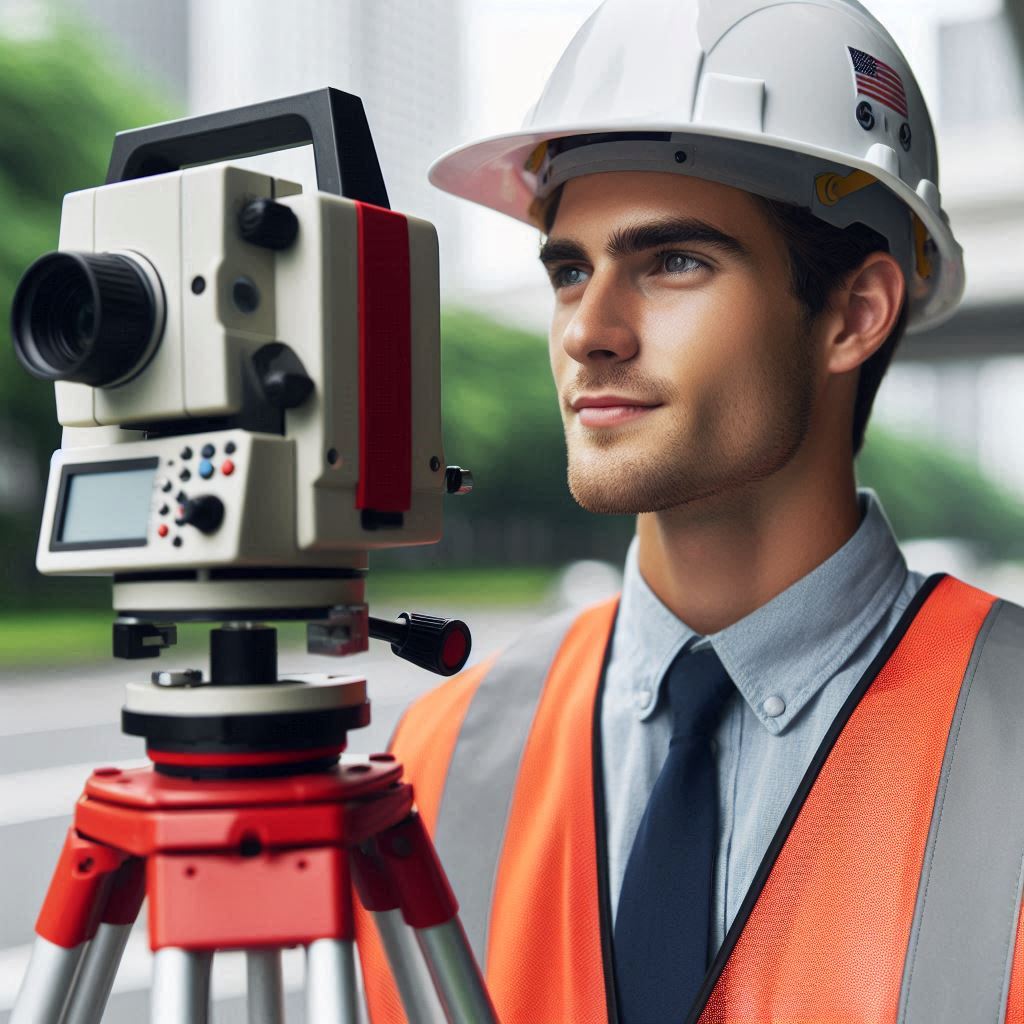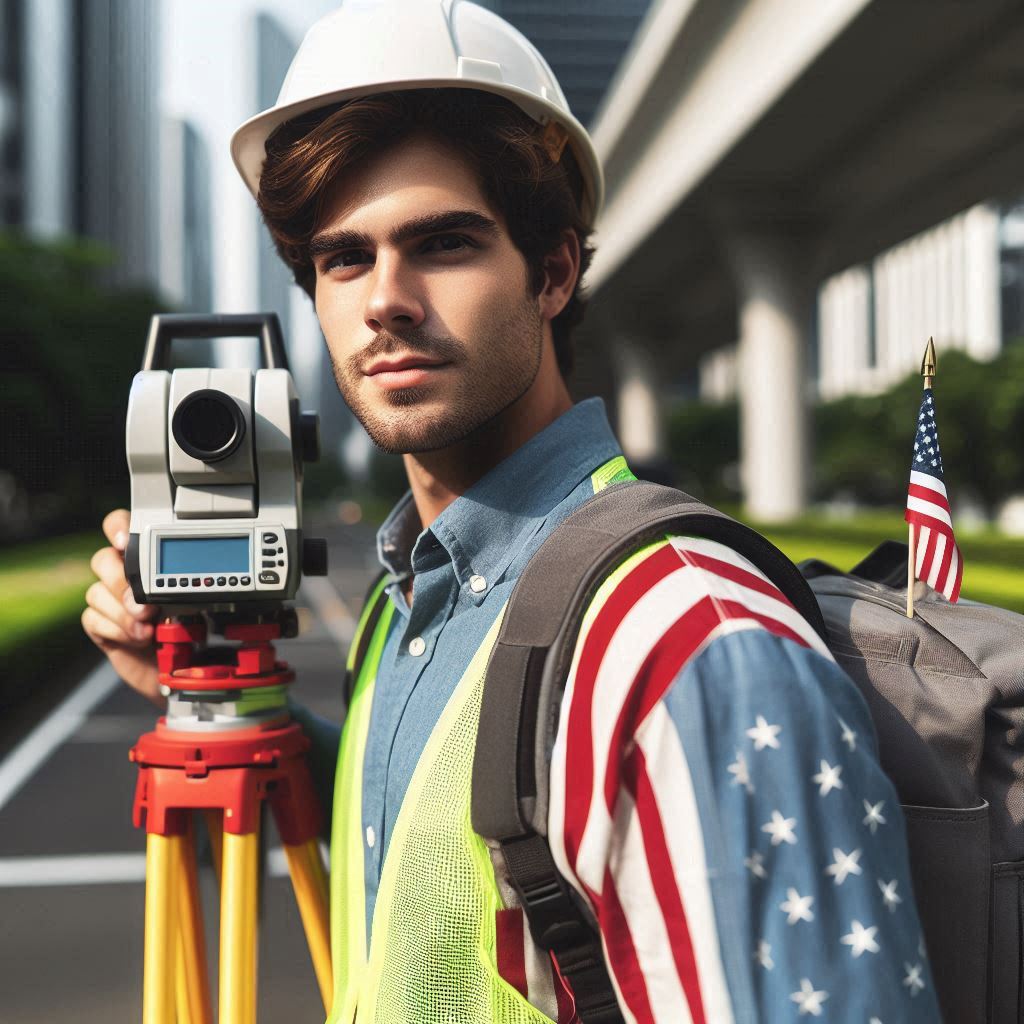Introduction
Drones, or unmanned aerial vehicles (UAVs), are aircraft that operate without a pilot on board.
These versatile tools are controlled remotely or autonomously, using pre-programmed flight paths or real-time controls.
In the fields of surveying and mapping, drones have transformed traditional methods of data collection.
They are equipped with high-resolution cameras, LiDAR sensors, and GPS technology, allowing them to capture detailed aerial imagery and precise spatial data from above.
Drones provide a unique vantage point, enabling surveyors and mappers to access and document areas that are difficult or impossible to reach by ground.
They can quickly cover large expanses of land, providing comprehensive and accurate data with remarkable efficiency.
This capability significantly reduces the time and cost associated with traditional surveying methods, which often require extensive manual labor and equipment.
The popularity and importance of drones in surveying and mapping have surged in recent years.
Technological advancements have made drones more affordable and accessible, expanding their use in various applications.
Their ability to deliver high-quality, real-time data has revolutionized industries like construction, agriculture, and environmental monitoring.
History of Drones in Surveying and Mapping
Overview of When Drones Were First Used for Surveying and Mapping Purposes
Drones, or unmanned aerial vehicles (UAVs), first appeared in surveying and mapping in the early 2000s.
Initially, they were primarily used for military reconnaissance and basic aerial tasks.
The concept of using drones for commercial applications in surveying and mapping began to gain traction around 2010.
During this period, drones equipped with basic cameras were introduced, marking the beginning of their application in these fields.
Early commercial drones provided a new way to capture aerial data, though their capabilities were limited by shorter flight times and lower-resolution imaging.
Evolution of Drone Technology in These Fields Over the Years
Drone technology has evolved rapidly since its initial introduction.
Early drones featured simple cameras and basic sensors, which provided limited functionality.
Over the years, technological advancements have significantly enhanced their capabilities.
Modern drones now include high-resolution cameras and sophisticated LiDAR sensors, which capture precise 3D measurements of terrain.
These improvements have increased the accuracy of data collected during surveys and mapping projects.
The development of extended battery life and lightweight materials has improved drone performance.
Enhanced GPS systems and advanced flight controls now enable drones to perform complex surveying missions with greater precision.
Real-time data processing has become a key feature, allowing for immediate analysis and reporting.
Additionally, software advancements have enabled drones to create detailed maps and 3D models through photogrammetry, stitching together images for a comprehensive view.
The cost of drones has decreased over time, making them more accessible to a broader range of professionals.
This affordability has led to widespread adoption across industries like construction, agriculture, and environmental monitoring.
Drones have become essential tools in these fields, providing efficiency and accuracy in surveying and mapping.
The ongoing evolution of drone technology continues to shape the future of these disciplines, offering enhanced capabilities and expanding their applications.
Benefits of Drones in Surveying and Mapping
Drones have revolutionized the field of surveying and mapping by providing a range of benefits that were not feasible with traditional methods.
In this section, we will explore the advantages that drones offer in this domain.
Increased efficiency and accuracy of data collection
One of the key benefits of using drones in surveying and mapping is the significantly increased efficiency and accuracy of data collection.
Drones equipped with advanced sensors and cameras can capture high-resolution images and create detailed maps in a fraction of the time it would take using traditional methods.
By flying over the area of interest, drones can capture a large amount of data quickly and efficiently.
This data can be processed using specialized software to create accurate maps and 3D models.
The speed and precision of drone data collection result in faster project completion times and more reliable data for analysis.
Cost-effectiveness compared to traditional surveying methods
Another advantage of using drones in surveying and mapping is their cost-effectiveness compared to traditional methods.
Drones are relatively inexpensive to operate and maintain, making them a more affordable option for many surveying projects.
Furthermore, the efficiency of drone data collection reduces the labor costs associated with traditional surveying methods.
With drones, fewer personnel are required to gather data, leading to lower overall project costs.
This makes drones a cost-effective solution for organizations looking to minimize expenses while maximizing the quality of their surveying and mapping projects.
Ability to reach difficult or dangerous terrain
Drones offer the unique advantage of being able to reach difficult or dangerous terrain that may be inaccessible or hazardous for surveyors using traditional methods.
Whether it’s a rugged mountainous region, a remote island, or a disaster-stricken area, drones can easily navigate these challenging environments to collect data.
By deploying drones in such areas, surveyors can obtain critical information without putting themselves at risk.
This capability of drones to access hard-to-reach locations ensures that surveying and mapping projects can be completed efficiently and safely, even in the most challenging conditions.
In review, the benefits of using drones in surveying and mapping are clear.
From increased efficiency and accuracy of data collection to cost-effectiveness and the ability to reach difficult terrain, drones offer a range of advantages that make them an invaluable tool in this field.
As technology continues to advance, drones will undoubtedly play an increasingly important role in transforming the way surveying and mapping projects are conducted.
Read: Public Health and Environmental Engineering
Applications of Drones in Surveying and Mapping
Aerial Surveying for Large-Scale Mapping Projects
Drones excel in aerial surveying, significantly enhancing large-scale mapping projects.
Traditional surveying methods can be labor-intensive and time-consuming, especially over extensive areas.
Drones, equipped with high-resolution cameras and GPS technology, quickly cover vast terrains with exceptional accuracy.
They capture detailed aerial imagery, which improves the precision of maps and reduces the need for extensive ground surveys.
This efficiency accelerates project timelines and lowers costs.
Drones provide a comprehensive view of large areas, making them invaluable for creating accurate, up-to-date maps of urban developments, natural landscapes, and remote regions.
3D Mapping and Modeling for Infrastructure Development
Drones are also pivotal in 3D mapping and modeling, crucial for infrastructure development.
By using drones equipped with advanced sensors and imaging technology, surveyors create detailed 3D models of construction sites and landscapes.
These models offer a realistic representation of terrains and structures, enhancing planning and design processes.
Engineers and architects benefit from precise visualizations, allowing for better assessment and decision-making.
Drones facilitate the creation of accurate, detailed models that support effective project planning, reduce errors, and improve collaboration among stakeholders.
This technology helps in visualizing complex projects, predicting potential issues, and optimizing designs.
Monitoring and Surveillance of Construction Sites
Drones provide excellent monitoring and surveillance capabilities for construction sites.
They offer real-time aerial views, enabling project managers to track progress and ensure compliance with design specifications.
Regular drone flights capture updates on construction activities, allowing for efficient site management.
Drones help identify deviations from plans, detect safety hazards, and verify that work adheres to schedules.
This proactive approach enhances site supervision and facilitates timely interventions.
The ability to capture high-resolution images and videos from the air provides a comprehensive overview that ground-based inspections cannot match.
Drones improve oversight, streamline project management, and contribute to successful project outcomes.
Basically, drones have profoundly impacted surveying and mapping by enhancing large-scale aerial surveying, advancing 3D mapping and modeling, and improving construction site monitoring.
Their ability to provide precise, real-time data and detailed visualizations makes them indispensable tools in modern surveying and mapping practices.
By integrating drones into these fields, professionals can achieve greater efficiency, accuracy, and effectiveness, driving progress and innovation in the industry.
Read: Environmental Engineers in the Mining Industry
Challenges and Limitations of Drones in Surveying and Mapping:
Regulatory Restrictions and Airspace Limitations
Drones have revolutionized surveying and mapping, but regulatory restrictions and airspace limitations pose significant challenges.
Regulatory agencies, like the FAA, enforce rules on drone usage to ensure safety.
These regulations include restrictions on flight altitudes, no-fly zones, and operational limits near airports.
Surveying and mapping professionals must navigate these restrictions to conduct effective drone operations.
Compliance with regulations is crucial to avoid legal issues and ensure safe flights.
Airspace limitations also affect drone operations.
Drones often need to avoid restricted airspace, which includes areas near airports and military zones.
Obtaining permissions and coordinating with air traffic control can be complex, especially in busy or regulated areas.
These constraints can impact the efficiency and scope of surveying and mapping projects, requiring careful planning and coordination.
Weather Conditions Affecting Drone Operation
Weather conditions significantly impact drone operations, affecting both flight stability and data quality.
Wind speeds, precipitation, and temperature variations can disrupt drone flights.
High winds can make it difficult for drones to maintain stable flight paths, potentially causing crashes or data inaccuracies.
Rain or snow can damage sensitive equipment and reduce visibility, complicating the data collection process.
Temperature extremes can also affect drone performance.
Cold weather can reduce battery life, while high temperatures may cause overheating.
Surveying and mapping professionals must account for these weather-related challenges to ensure successful drone operations.
Proper planning and weather forecasting are essential for minimizing disruptions and ensuring accurate data collection.
Transform Your Career Today
Unlock a personalized career strategy that drives real results. Get tailored advice and a roadmap designed just for you.
Start NowData Processing and Interpretation Challenges
Drone technology generates vast amounts of data that require careful processing and interpretation.
High-resolution imagery and 3D models are often produced, demanding sophisticated software and expertise.
Processing this data involves stitching images together, correcting distortions, and analyzing various features.
The sheer volume of data can be overwhelming, necessitating powerful computers and specialized software for effective management.
Interpreting the processed data also presents challenges.
Surveying and mapping professionals must extract meaningful insights from complex datasets.
This task requires a deep understanding of both the technology and the specific needs of the project.
Errors in data interpretation can lead to inaccurate results and affect the quality of the final maps and models.
In review, while drones significantly enhance surveying and mapping, they also face challenges.
Regulatory restrictions and airspace limitations, weather conditions, and data processing issues all impact their effectiveness.
Navigating these challenges requires careful planning, adherence to regulations, and expertise in data management.
Despite these hurdles, drones continue to transform the field, offering new capabilities and efficiencies in data collection and analysis.
Read: Tips for Writing Environmental Engineering Reports

See Related Content: Remote Work Opportunities for Systems Engineers
Future Trends in Drone Technology for Surveying and Mapping
Integration of Artificial Intelligence for Data Analysis
Drones have revolutionized surveying and mapping, especially with the integration of artificial intelligence (AI) for data analysis.
AI algorithms enhance the processing of aerial imagery captured by drones.
These algorithms can automatically identify and classify features such as buildings, roads, and vegetation.
AI-driven analytics streamline the data processing pipeline, reducing the time needed to generate detailed maps and reports.
By learning from vast datasets, AI improves accuracy and provides valuable insights into land use and environmental changes.
This technology not only speeds up data analysis but also enhances the precision of the results.
Development of Drone Swarms for Large-Scale Mapping Projects
The development of drone swarms has significantly advanced large-scale mapping projects.
Swarms consist of multiple drones working in coordination to cover extensive areas efficiently.
This approach allows for faster data collection over large and complex sites compared to single-drone operations.
Drone swarms can fly predetermined flight paths, capturing overlapping images that are then stitched together to create comprehensive maps.
The use of multiple drones simultaneously increases coverage and reduces the time required for extensive surveys.
This technology is particularly useful for mapping large infrastructure projects, agricultural fields, and natural landscapes.
Advancements in Sensor Technology for More Precise Data Collection
Recent advancements in sensor technology have further improved the precision of data collected by drones.
Modern drones are equipped with high-resolution cameras, LiDAR sensors, and multispectral sensors.
High-resolution cameras capture detailed imagery, while LiDAR sensors provide accurate 3D measurements of terrain and structures.
Multispectral sensors can analyze different wavelengths of light, offering insights into vegetation health and soil conditions.
These advanced sensors enhance the ability to gather precise data, resulting in more accurate and reliable maps.
Improved sensor technology also enables better detection of subtle features and changes in the environment.
Overall, drones have transformed the field of surveying and mapping through the integration of AI, development of drone swarms, and advancements in sensor technology.
AI enhances data analysis by automating feature recognition and improving accuracy.
Drone swarms enable efficient large-scale mapping, covering more ground in less time.
Advanced sensors provide precise data collection, leading to detailed and reliable results.
Together, these innovations have greatly increased the efficiency, accuracy, and scope of aerial surveying and mapping projects.
As technology continues to evolve, drones will play an even more critical role in shaping the future of surveying and mapping.
Read: Sustainable Wastewater Treatment Methods
Learn More: Essential Skills for Surveying and Mapping Technicians
Case Studies of Successful Drone Applications in Surveying and Mapping
Examples of How Drones Have Been Used in Real-World Mapping Projects
Drones have revolutionized real-world mapping projects across various industries.
In construction, drones provide detailed site surveys and progress monitoring.
They capture high-resolution images that help track project development and identify potential issues early.
For environmental studies, drones collect data on vegetation, wildlife, and land changes.
They offer precise mapping for conservation efforts and habitat monitoring.
In agriculture, drones create detailed crop maps to monitor plant health and optimize resource use.
They gather data on soil conditions and crop growth, enabling farmers to make informed decisions.
Drones are also used in urban planning to map city layouts and analyze infrastructure.
Their aerial perspectives help planners visualize and assess development projects more effectively.
During disaster response, drones assist in mapping affected areas quickly and accurately.
They provide real-time images that aid in rescue operations and damage assessments.
Additionally, drones support archaeological surveys by capturing detailed site layouts and uncovering hidden structures.
Results and Benefits of Using Drones Compared to Traditional Methods
Using drones in mapping projects offers several advantages over traditional methods.
Drones cover large areas quickly, reducing the time needed for data collection.
Traditional methods often require extensive ground surveys and manual measurements, which are time-consuming and labor-intensive.
Drones provide high-resolution images and data with exceptional accuracy.
They capture detailed aerial views that are difficult to achieve with ground-based surveys.
This precision leads to more accurate mapping and better decision-making.
Additionally, drones can access hard-to-reach or hazardous areas safely, minimizing risks for surveyors.
Cost savings are another significant benefit of using drones.
Drones reduce the need for expensive equipment and extensive labor associated with traditional surveying methods.
They lower overall project costs by streamlining data collection and reducing the time required for analysis.
The ability to gather real-time data enhances the efficiency of mapping projects.
Drones transmit live images and data, allowing for immediate analysis and timely adjustments.
This capability improves project management and response times, especially in dynamic or emergency situations.
Conclusion
Drones have significantly transformed the fields of surveying and mapping with their advanced capabilities and efficiency.
Their impact is profound, as they offer high-resolution aerial imagery that enhances data accuracy and detail.
Drones allow surveyors to capture comprehensive views of large areas quickly and with greater precision than traditional methods.
This technological advancement reduces the need for extensive fieldwork and mitigates safety risks associated with challenging terrains and hazardous conditions.
The use of drones in surveying provides detailed aerial perspectives that improve the overall quality of mapping projects.
They can easily access and document hard-to-reach or remote locations, which were previously difficult or impossible to survey accurately.
This capability is particularly valuable for applications such as land development, environmental monitoring, and infrastructure planning.
By offering real-time data collection and immediate visual feedback, drones streamline workflows and enhance the efficiency of surveying operations.
Embracing drone technology is essential for future advancements in these fields.
As drone technology continues to evolve, its capabilities will expand, providing even more precise and comprehensive data.




